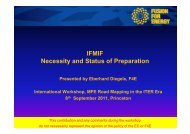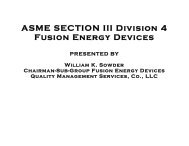Peng, Y.K.M. - Advanced Projects Homepage
Peng, Y.K.M. - Advanced Projects Homepage
Peng, Y.K.M. - Advanced Projects Homepage
Create successful ePaper yourself
Turn your PDF publications into a flip-book with our unique Google optimized e-Paper software.
ST startup & plasma<br />
source R&D for FNSF<br />
Y.-K. M. <strong>Peng</strong>, for<br />
R.H. Goulding, J.B. Caughman, L.W. Owen,<br />
T. S. Bigelow, S.J. Diem, G.Y. Chen, J.M. Canik,<br />
T.M. Biewer, S.J. Meitner, W.D. McGinnis (ORNL,<br />
USA)<br />
J. Mailloux, C. Gurl, J. R. Hawes, V. Chevchenko,<br />
J.H. Griffiths, P, Finburg (CCFE, U.K.)<br />
G.N. Luo, B. Li, X. Zhu, F. Ding (ASIPP, PRC)<br />
First IAEA DEMO Program Workshop<br />
UCLA, Los Angeles, CA, USA<br />
15-18 October 2012
Example fusion nuclear science facility<br />
(FNSF) considerations<br />
• Objective: Develop experimental data base for all fusion reactor<br />
internals and, in parallel with ITER, provide the basis for DEMO<br />
• Some important up-front questions<br />
– FNSF geometry: aspect ratio; other confinement configurations?<br />
– Materials: what to be used, and tested, in FNSF?<br />
• Measures of required performance<br />
– Research in full fusion nuclear environment?<br />
– How much power demonstration tests to include?<br />
– What results to deliver, at what cost and risk?<br />
2 Managed by UT-Battelle<br />
for the U.S. Department of Energy Juergen Rapp, PFC meeting, June 22 nd 2012
Adjacent possible, compact normal<br />
conducting FNSF concepts include ST<br />
N/C Concepts I II III<br />
R (m) 0.85 1.3 2.7<br />
P DT (MW) 35 25 – 75 100 – 200<br />
W L (MW/m 2 ) 1.0 0.3 – 1.0 0.5 – 1.0<br />
Q DT ≤ 1 ≤ 3 ≤ 7<br />
Poten
Outline: ST startup and plasma source<br />
research to reduce cost and risk of FNSF<br />
• Of interest to compact FNSF options that use steady state<br />
normal conducting magnets<br />
• RF plasma startup free of central solenoid<br />
– Smallest possible size and fusion power for given neutron flux<br />
– Intense plasma source research expected to result in higher heat<br />
fluxes<br />
• RF-driven, intense plasma source research in linear<br />
configuration<br />
– No solid electrodes → intrinsically steady state; add no impurities<br />
– Flexibility to test different PMI/PFC options at reduced size & cost<br />
• Summary<br />
4 Managed by UT-Battelle<br />
for the U.S. Department of Energy Juergen Rapp, PFC meeting, June 22 nd 2012
ST NSTX, research Pegasus, increased MAST, QUEST, to 24 LATE, experiments TST-2, TS-3, in two TS-4,<br />
decades, HIST, SUNIST preparing are conducting NSTX-U start-up & MAST-U research<br />
for 2015-16<br />
NSTX (US)<br />
Pegasus (US)<br />
LTX (US)<br />
Globus-M (RF)<br />
Proto-<br />
Sphera (It)<br />
5 Managed by UT-Battelle<br />
for the U.S. Department of Energy Juergen Rapp, PFC meeting, June 22nd ETE (Brazil) SUNIST (PRC) UTST (J)<br />
2012<br />
LATE (J) HIST (J)<br />
TS-4 (J)<br />
MAST (UK)<br />
QUEST (J)<br />
TST-2 (J)
6 Managed by UT-Battelle<br />
for the U.S. Department of Energy Juergen Rapp, PFC meeting, June 22 nd 2012
7 Managed by UT-Battelle<br />
for the U.S. Department of Energy Juergen Rapp, PFC meeting, June 22 nd 2012
8 Managed by UT-Battelle<br />
for the U.S. Department of Energy Juergen Rapp, PFC meeting, June 22 nd 2012
9 Managed by UT-Battelle<br />
for the U.S. Department of Energy Juergen Rapp, PFC meeting, June 22 nd 2012
10 Managed by UT-Battelle<br />
for the U.S. Department of Energy Juergen Rapp, PFC meeting, June 22 nd 2012
11 Managed by UT-Battelle<br />
for the U.S. Department of Energy Juergen Rapp, PFC meeting, June 22 nd 2012
ORNL gyrotron & wave guide components to be added<br />
and commissioned for MAST experiments in early 2013<br />
12 Managed by UT-Battelle<br />
for the U.S. Department of Energy Juergen Rapp, PFC meeting, June 22 nd 2012<br />
• Gyrotron: 350 kW, 28 GHz, 300<br />
ms<br />
• Improved wave guide<br />
– Loss measurement & reduction<br />
– New route<br />
– Mitre bends<br />
– Corrugated wave guide<br />
• Goal: test delivering 200 kW to<br />
plasma for 200 ms → 100kA
Summary – ST start-up research<br />
• Solenoid-free plasma start-up test: a major worldwide research<br />
collaboration<br />
• Produced 30-50 kA currents at 0.2-0.4 A/W for R=0.5-0.8m<br />
• Progressing toward 100 kA level tests to understand physics<br />
principles in 2013<br />
13 Managed by UT-Battelle<br />
for the U.S. Department of Energy Juergen Rapp, PFC meeting, June 22 nd 2012
PMI/PFC choices depend on<br />
options of internals<br />
ITER<br />
14 Managed by UT-Battelle<br />
for the U.S. Department of Energy Juergen Rapp, PFC meeting, June 22nd 2012<br />
Internals Options:<br />
A) Hot divertor surface with H 2 O-cooled<br />
steel wall components (ITER)<br />
1. Water-cooled W surface divertors<br />
2. Water-cooled steel shield-blocks<br />
3. Six TBM’s each of ~1m 2 area<br />
B) All-W PFC’s (EU)<br />
1. Surface T = 750C – 1000C<br />
2. Divertor “fingers” with He jet cooling<br />
3. Solid or Pb-Li liquid breeder blankets<br />
C) Large flowing liquid Li PFC’s (US)<br />
1. Surface T = 450C+, inlet T ~ 200C<br />
2. He cooled internals<br />
3. Avoid solid surface PMI<br />
D) Water-cooled solid breeder blankets (JN)<br />
1. Super critical steam ~300C, He-purged<br />
solid breeder<br />
2. Extend LWR materials and technologies<br />
3. Extend LWR power conversion efficiency<br />
Different PMI/PFC research options favor the<br />
flexibility of the linear testing configuration
15 Managed by UT-Battelle<br />
for the U.S. Department of Energy Juergen Rapp, PFC meeting, June 22 nd 2012
Plasma source goal: produce high-recycling, strongly<br />
coupled PMI regime, guided by ITER divertor plasma<br />
1m<br />
ITER divertor channel<br />
ITER Plasma Core<br />
Plasma Boundary<br />
Plasma Heat &<br />
Particle Fluxes<br />
Divertor Target<br />
Upstream<br />
Hot Plasma Channel<br />
Downstream<br />
10 MW/m2 max on target<br />
What source plasma parameters are required?<br />
16 Managed by UT-Battelle<br />
for the U.S. Department of Energy Juergen Rapp, PFC meeting, June 22 nd 2012<br />
High-recycling, strongly<br />
coupled PMI regime<br />
Linear plasma channel<br />
connected to a test target<br />
Intense<br />
Source<br />
Upstream Downstream<br />
Hot Plasma Channel<br />
Magnetic Field<br />
10 MW/m 2<br />
Test Target
Building block: Large, high-density helicon<br />
• Plasma diameter = 12 cm<br />
• n e found to maximize at (He)<br />
– B middle ~ 0.07T & 0.3T<br />
– B max /B middle ~ 2.5 & 6.7<br />
– n e ≤ 6x10 19 /m 3<br />
• Injected power ≤ 90kW (D)<br />
– n e ≤ 4x10 19 /m 3 (70kW, 1150 sccm)<br />
• Stationary condition in plasma-neutralswall<br />
surface interaction time scales<br />
0<br />
0 1 2 Z(m)→<br />
18 Managed by UT-Battelle<br />
for the U.S. Department of Energy Juergen Rapp, PFC meeting, June 22nd 0<br />
2.28 2.3 2.32 2.34 2.36 2.38<br />
2012<br />
Time (s)<br />
n e (10 19 /m 3 )<br />
↑<br />
R(m)<br />
0.1<br />
0.05<br />
n e ( 10 19 m 3 )<br />
6<br />
4<br />
Helicon B-field lines<br />
B max<br />
B middle<br />
2<br />
Power = 100kW, He<br />
0<br />
0 0.2<br />
6<br />
0.4 Bmiddle (T) →<br />
4<br />
2<br />
0<br />
1 3 5 Bmax /Bmiddle →<br />
5<br />
4<br />
3<br />
2<br />
1<br />
upstream<br />
downstream<br />
A<br />
B<br />
A<br />
RF Power<br />
B
Building block: electron<br />
heating in over-dense<br />
mirror plasmas<br />
• Tested whistler and EBW launching and<br />
absorption at modest fields and densities<br />
• Demonstrated absorption and density<br />
increase in over-dense plasmas<br />
• Heating affected by neutral pressure<br />
20 Managed by UT-Battelle<br />
for the U.S. Department of Energy Juergen Rapp, PFC meeting, June 22nd 0.0<br />
2012<br />
Plasma Density (10 11 /cm 3 )<br />
Electron Temperature (eV)<br />
12.0<br />
10.0<br />
8.0<br />
6.0<br />
4.0<br />
2.0<br />
18 GHz = 8 kW<br />
6 GHz = 2.3 kW<br />
Ne 18 GHz<br />
Ne 18 GHz + 6 GHz EBW<br />
Ne 18 GHz + 6 GHz Whistler<br />
Over-dense<br />
at 6 GHz<br />
Pressure ~ 5x10<br />
0.0<br />
0.0 10.0 20.0 30.0 40.0<br />
Radial Position (cm)<br />
50.0<br />
-4 Torr<br />
10.0<br />
8.0<br />
6.0<br />
4.0<br />
2.0<br />
18 GHz = 8 kW<br />
6 GHz = 2.3 kW<br />
Pressure ~ 5x10 -4 Torr<br />
Te 18GHz<br />
Te 18GHz+6GHz EBW<br />
Te 18GHz + 6GHz Whistler<br />
0.0 10.0 20.0 30.0 40.0 50.0<br />
Radial Position (cm)
Integration objectives, capabilities, and research<br />
• Investigate the addition of electron<br />
heating to helicon plasma<br />
– Heating of helicon plasma electrons<br />
– Effects back on helicon plasma production<br />
– Neutral and plasma density control<br />
– RF power-to-plasma heat flux efficiency<br />
– Effects of plasma and impurity flow-back<br />
– ICRF launcher-plasma interactions<br />
magnetic<br />
field lines<br />
neutral & plasma<br />
density control<br />
magnets<br />
helicon<br />
plasma<br />
helicon<br />
launcher<br />
whistler wave<br />
launcher<br />
21 Managed by UT-Battelle<br />
for the U.S. Department of Energy Juergen Rapp, PFC meeting, June 22nd 2012<br />
(helicon + electron heaters)<br />
4m<br />
ICRF launcher<br />
plasma interaction<br />
EBW<br />
launcher<br />
electron<br />
heating<br />
flow<br />
back<br />
plasma<br />
heat flux<br />
moveable<br />
diagnostic<br />
disk-target<br />
ballast<br />
tank
Integration test (PhIX) assembly and facility<br />
• Assembly completed in September, 2012<br />
Building 7625<br />
22 Managed by UT-Battelle<br />
for the U.S. Department of Energy Juergen Rapp, PFC meeting, June 22 nd 2012
Stepping from Integration<br />
to Prototype experiment<br />
• Simulation under way for Integration test<br />
• Add whistler and EBW heating (20 kW)<br />
• Extend to Prototype<br />
– Source fueling and power handling<br />
– Plasma boundary & neutral pressure<br />
– Ion heating (revive Archimedes RF supply!)<br />
– Plasma & neutrals flow to target & back-flow<br />
– Target particle recycling & impurity control<br />
gas injection<br />
& W armor<br />
W plasma limiter /<br />
neutral baffles<br />
↑<br />
Z(m)<br />
Prototype High Intensity Source Experiment (PHISX)<br />
23 Managed by UT-Battelle<br />
for the U.S. Department of Energy Juergen Rapp, PFC meeting, June 22nd 2012<br />
fueling<br />
Integration simulation<br />
helicon<br />
electron<br />
heating<br />
source-to-target<br />
transport section<br />
W target<br />
assembly<br />
backflow<br />
0.1<br />
0<br />
0 1 2 Z(m)→<br />
9<br />
ion cyclotron<br />
wave<br />
P elec (MW/m 3 )<br />
ne (1019 /m3 1.8 1.4<br />
) 0.4<br />
10 8<br />
Te (eV) 3<br />
0<br />
0<br />
1
ASIPP-ORNL collaboration on Prototype<br />
• Critical new components: CAD concept → 3D models → fab drawings →<br />
fabrication → inspection → shipping (early FY13)<br />
• Include all-tungsten plasma facing components (armor, limiter-baffles, targets)<br />
• Enable proof-of-principle experimentation on new high intensity plasma source<br />
– Capable for up to 15 MW/m 2 peak thermal plasma heat flux, up to 1-s<br />
• Experimental research collaboration, involving US and CN researchers<br />
ASIPP in-kind contribution<br />
24 Managed by UT-Battelle<br />
for the U.S. Department of Energy Juergen Rapp, PFC meeting, June 22 nd 2012
Summary – ST startup, plasma source<br />
research<br />
• Solenoid-free plasma start-up test: a major worldwide research<br />
collaboration<br />
• Produced 30-50 kA currents at 0.2-0.5 A/W for R=0.5-0.8m<br />
• Progressing toward 100 kA level tests to understand physics<br />
principle in FY13<br />
• Intense plasma source required to enable flexible testing of several<br />
PMI/PFC options<br />
• Determined required plasma source parameters<br />
• Roadmap: Helicon + electron heating ⇒ Integration (FY13) ⇒<br />
Prototype (ASIPP-ORNL collaboration, hopefully FY14 operation)<br />
These research efforts aim to enable compact, lower<br />
cost options of FNSF<br />
25 Managed by UT-Battelle<br />
for the U.S. Department of Energy Juergen Rapp, PFC meeting, June 22 nd 2012








